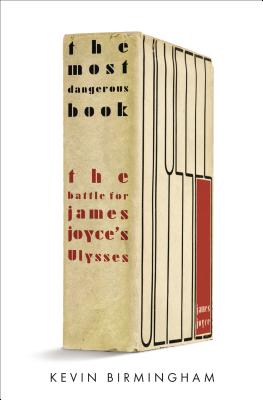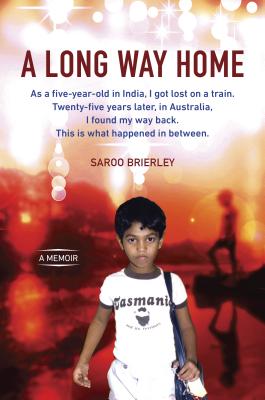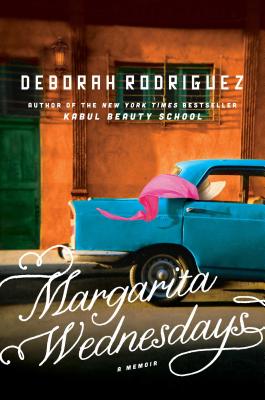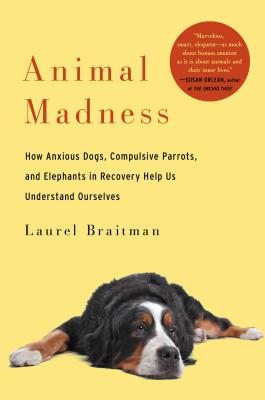For more than a decade, the book that literary critics now consider the most important novel in the English language was illegal to own, sell, advertise or purchase in most of the English-speaking world. James Joyce’s big blue book, Ulysses, ushered in the modernist era and changed the novel for all time. But the genius of Ulysses was also its danger: it omitted absolutely nothing. All of the minutiae of Leopold Bloom’s day, including its unspeakable details, unfold with careful precision in its pages. The New York Society for the Suppression of Vice immediately banned the novel as “obscene, lewd, and lascivious.” Joyce, along with some of the most important publishers and writers of his era, had to fight for years to win the freedom to publish it. The Most Dangerous Book tells the remarkable story surrounding Ulysses, from the first stirrings of Joyce’s inspiration in 1904 to its landmark federal obscenity trial in 1933.
Literary historian Kevin Birmingham follows Joyce’s years as a young writer, his feverish work on his literary masterpiece, and his ardent love affair with Nora Barnacle, the model for Molly Bloom. Joyce and Nora socialized with literary greats like Ezra Pound, Ernest Hemingway, T. S. Eliot and Sylvia Beach. Their support helped Joyce fight an array of anti-vice crusaders while his book was disguised and smuggled, pirated and burned in the United States and Britain. The long struggle for publication added to the growing pressures of Joyce’s deteriorating eyesight, finances and home life.
Salvation finally came from the partnership of Bennett Cerf, the cofounder of Random House, and Morris Ernst, a dogged civil liberties lawyer. With their stewardship, the case ultimately rested on the literary merit of Joyce’s master work. The sixty-year-old judicial practices governing obscenity in the United States were overturned because a federal judge could get inside Molly Bloom’s head.
Birmingham’s archival work brings to light new information about both Joyce and the story surrounding Ulysses. Written for ardent Joyceans as well as novices who want to get to the heart of the greatest novel of the twentieth century, The Most Dangerous Book is a gripping examination of how the world came to say yes to Ulysses.
Novella Carpenter picks up the phone one day to receive some disturbing news: her father has officially gone missing. Carpenter’s father, George—a back-to-the-land homesteader and troubled Korean War veteran—has spent decades battling his inner demons while largely absenting himself from his children’s lives. Though George is ultimately found, Carpenter is forced to confront the truth: her time with her dad—now seventy-three years old—is limited, and the moment to restore their relationship is now. Gone Feral is the story of Carpenter’s search for her parents’ broken past in the harsh wilds of Idaho.
The story starts in San Miguel de Allende in 1969, where Carpenter’s free-spirited parents meet and fall in love. Their whirlwind romance continues through Europe and ends on 180 acres near Idaho’s Clearwater River. Carpenter and her sister are born into a free, roaming childhood, but soon the harsh reality of living on the land—loneliness, backbreaking labor—tears the family apart. Carpenter’s mother packs the girls and heads for the straight life in Washington State while George remains on the ranch, tied to the land and his vision of freedom.
In Gone Feral, Carpenter—now a grown woman leading an untraditional life, not unlike her parents’, raising livestock and growing vegetables in the city—finds herself contemplating a family of her own. Before that can happen, she knows she has to return to Idaho to discover why her father chose this life of solitude. She quickly finds that George is not living the principled, romantic life she imagined, and the truth is more complicated—and dangerous—than anything she suspected.
As she comes to know the real George, Carpenter looks to her own life and comes to recognize her father’s legacy in their shared love of animals, of nature, and of the written word; their dangerous stubbornness and isolating independence. Finally, Gone Feral sees the birth of Carpenter’s own daughter, an experience that teaches that a parent’s love is itself a wild thing: unknowable, fierce, and ever changing. In reckoning with her past, Carpenter clears the road to her future.
Raw, funny, unsentimental, alive with unforgettable characters and pitch-perfect dialogue, Gone Feral marks Carpenter’s transformative passage from daughter to mother, a wry and rough tale of life lived on the margins and redemption between generations.
In answer to the question of what happened following her New York Times bestseller Kabul Beauty School, Deborah Rodriquez is back with a new memoir.
Irreverent, insightful, and blatantly honest, Deborah takes us along on her inspiring journey of self-discovery and renewal after she is forced to flee Afghanistan in 2007. She first lands in California, where she feels like a misfit teetering on the brink of sanity. Where was that fearless redhead who stared danger in the face back in Kabul?
After being advised to commune with glowworms and sit in contemplation for one year, Rodriguez finally packs her life and her cat into her Mini Cooper and moves to a seaside town in Mexico. Despite having no plan, no friends, and no Spanish, a determined Rodriguez soon finds herself swept up in a world where the music never stops and a new life can begin. Her adventures and misadventures among the expats and locals help lead the way to new love, new family, and a new sense of herself.
In the magic of Mexico, she finds the hairdresser within, and builds the life she never knew was possible--a life on her own terms.
For the first time, a historian of science draws evidence from across the world to show how humans and other animals are astonishingly similar when it comes to their feelings and the ways in which they lose their minds.
Charles Darwin developed his evolutionary theories by looking at physical differences in Galapagos finches and fancy pigeons. Alfred Russell Wallace investigated a range of creatures in the Malay Archipelago. Laurel Braitman got her lessons closer to home--by watching her dog. Oliver snapped at flies that only he could see, ate Ziploc bags, towels, and cartons of eggs. He suffered debilitating separation anxiety, was prone to aggression, and may even have attempted suicide. Her experience with Oliver forced Laurel to acknowledge a form of continuity between humans and other animals that, first as a biology major and later as a PhD student at MIT, she'd never been taught in school. Nonhuman animals can lose their minds. And when they do, it often looks a lot like human mental illness.
Thankfully, all of us can heal. As Laurel spent three years traveling the world in search of emotionally disturbed animals and the people who care for them, she discovered numerous stories of recovery: parrots that learn how to stop plucking their feathers, dogs that cease licking their tails raw, polar bears that stop swimming in compulsive circles, and great apes that benefit from the help of human psychiatrists. How do these animals recover? The same way we do: with love, with medicine, and above all, with the knowledge that someone understands why we suffer and what can make us feel better.
After all of the digging in the archives of museums and zoos, the years synthesizing scientific literature, and the hours observing dog parks, wildlife encounters, and amusement parks, Laurel found that understanding the emotional distress of animals can help us better understand ourselves.
Literary historian Kevin Birmingham follows Joyce’s years as a young writer, his feverish work on his literary masterpiece, and his ardent love affair with Nora Barnacle, the model for Molly Bloom. Joyce and Nora socialized with literary greats like Ezra Pound, Ernest Hemingway, T. S. Eliot and Sylvia Beach. Their support helped Joyce fight an array of anti-vice crusaders while his book was disguised and smuggled, pirated and burned in the United States and Britain. The long struggle for publication added to the growing pressures of Joyce’s deteriorating eyesight, finances and home life.
Salvation finally came from the partnership of Bennett Cerf, the cofounder of Random House, and Morris Ernst, a dogged civil liberties lawyer. With their stewardship, the case ultimately rested on the literary merit of Joyce’s master work. The sixty-year-old judicial practices governing obscenity in the United States were overturned because a federal judge could get inside Molly Bloom’s head.
Birmingham’s archival work brings to light new information about both Joyce and the story surrounding Ulysses. Written for ardent Joyceans as well as novices who want to get to the heart of the greatest novel of the twentieth century, The Most Dangerous Book is a gripping examination of how the world came to say yes to Ulysses.
The miraculous and triumphant story of a young man who rediscovers not only his childhood life and home…but an identity long-since left behind.
At only five years old, Saroo Brierley got lost on a train in India. Unable to read or write or recall the name of his hometown or even his own last name, he survived alone for weeks on the rough streets of Calcutta before ultimately being transferred to an agency and adopted by a couple in Australia.
Despite his gratitude, Brierley always wondered about his origins. Eventually, with the advent of Google Earth, he had the opportunity to look for the needle in a haystack he once called home, and pore over satellite images for landmarks he might recognize or mathematical equations that might further narrow down the labyrinthine map of India. One day, after years of searching, he miraculously found what he was looking for and set off to find his family.
A Long Way Home is a moving, poignant, and inspirational true story of survival and triumph against incredible odds. It celebrates the importance of never letting go of what drives the human spirit: hope.
When Saroo Brierley used Google Earth to find his long-lost birthplace half a world away, his story made global headlines. That story is being published in several languages around the world and is currently being adapted into a major feature film. Brierley was born in Khandwa, Madhya Pradesh, India. He currently lives in Hobart, Tasmania.
At only five years old, Saroo Brierley got lost on a train in India. Unable to read or write or recall the name of his hometown or even his own last name, he survived alone for weeks on the rough streets of Calcutta before ultimately being transferred to an agency and adopted by a couple in Australia.
Despite his gratitude, Brierley always wondered about his origins. Eventually, with the advent of Google Earth, he had the opportunity to look for the needle in a haystack he once called home, and pore over satellite images for landmarks he might recognize or mathematical equations that might further narrow down the labyrinthine map of India. One day, after years of searching, he miraculously found what he was looking for and set off to find his family.
A Long Way Home is a moving, poignant, and inspirational true story of survival and triumph against incredible odds. It celebrates the importance of never letting go of what drives the human spirit: hope.
When Saroo Brierley used Google Earth to find his long-lost birthplace half a world away, his story made global headlines. That story is being published in several languages around the world and is currently being adapted into a major feature film. Brierley was born in Khandwa, Madhya Pradesh, India. He currently lives in Hobart, Tasmania.
The story starts in San Miguel de Allende in 1969, where Carpenter’s free-spirited parents meet and fall in love. Their whirlwind romance continues through Europe and ends on 180 acres near Idaho’s Clearwater River. Carpenter and her sister are born into a free, roaming childhood, but soon the harsh reality of living on the land—loneliness, backbreaking labor—tears the family apart. Carpenter’s mother packs the girls and heads for the straight life in Washington State while George remains on the ranch, tied to the land and his vision of freedom.
In Gone Feral, Carpenter—now a grown woman leading an untraditional life, not unlike her parents’, raising livestock and growing vegetables in the city—finds herself contemplating a family of her own. Before that can happen, she knows she has to return to Idaho to discover why her father chose this life of solitude. She quickly finds that George is not living the principled, romantic life she imagined, and the truth is more complicated—and dangerous—than anything she suspected.
As she comes to know the real George, Carpenter looks to her own life and comes to recognize her father’s legacy in their shared love of animals, of nature, and of the written word; their dangerous stubbornness and isolating independence. Finally, Gone Feral sees the birth of Carpenter’s own daughter, an experience that teaches that a parent’s love is itself a wild thing: unknowable, fierce, and ever changing. In reckoning with her past, Carpenter clears the road to her future.
Raw, funny, unsentimental, alive with unforgettable characters and pitch-perfect dialogue, Gone Feral marks Carpenter’s transformative passage from daughter to mother, a wry and rough tale of life lived on the margins and redemption between generations.
In answer to the question of what happened following her New York Times bestseller Kabul Beauty School, Deborah Rodriquez is back with a new memoir.
Irreverent, insightful, and blatantly honest, Deborah takes us along on her inspiring journey of self-discovery and renewal after she is forced to flee Afghanistan in 2007. She first lands in California, where she feels like a misfit teetering on the brink of sanity. Where was that fearless redhead who stared danger in the face back in Kabul?
After being advised to commune with glowworms and sit in contemplation for one year, Rodriguez finally packs her life and her cat into her Mini Cooper and moves to a seaside town in Mexico. Despite having no plan, no friends, and no Spanish, a determined Rodriguez soon finds herself swept up in a world where the music never stops and a new life can begin. Her adventures and misadventures among the expats and locals help lead the way to new love, new family, and a new sense of herself.
In the magic of Mexico, she finds the hairdresser within, and builds the life she never knew was possible--a life on her own terms.
For the first time, a historian of science draws evidence from across the world to show how humans and other animals are astonishingly similar when it comes to their feelings and the ways in which they lose their minds.
Charles Darwin developed his evolutionary theories by looking at physical differences in Galapagos finches and fancy pigeons. Alfred Russell Wallace investigated a range of creatures in the Malay Archipelago. Laurel Braitman got her lessons closer to home--by watching her dog. Oliver snapped at flies that only he could see, ate Ziploc bags, towels, and cartons of eggs. He suffered debilitating separation anxiety, was prone to aggression, and may even have attempted suicide. Her experience with Oliver forced Laurel to acknowledge a form of continuity between humans and other animals that, first as a biology major and later as a PhD student at MIT, she'd never been taught in school. Nonhuman animals can lose their minds. And when they do, it often looks a lot like human mental illness.
Thankfully, all of us can heal. As Laurel spent three years traveling the world in search of emotionally disturbed animals and the people who care for them, she discovered numerous stories of recovery: parrots that learn how to stop plucking their feathers, dogs that cease licking their tails raw, polar bears that stop swimming in compulsive circles, and great apes that benefit from the help of human psychiatrists. How do these animals recover? The same way we do: with love, with medicine, and above all, with the knowledge that someone understands why we suffer and what can make us feel better.
After all of the digging in the archives of museums and zoos, the years synthesizing scientific literature, and the hours observing dog parks, wildlife encounters, and amusement parks, Laurel found that understanding the emotional distress of animals can help us better understand ourselves.





No comments:
Post a Comment